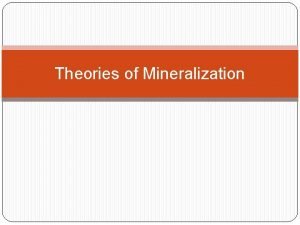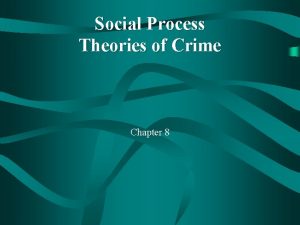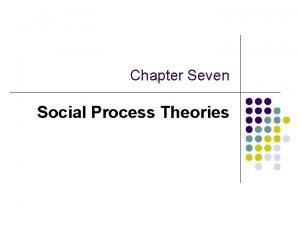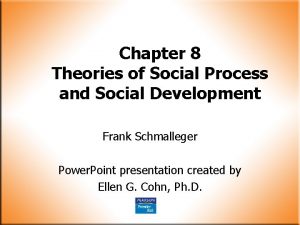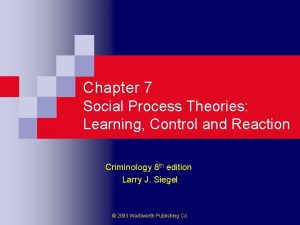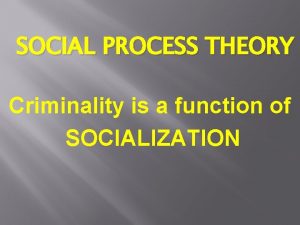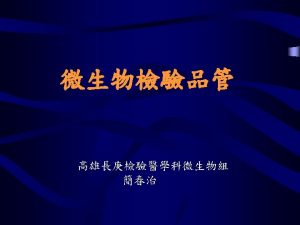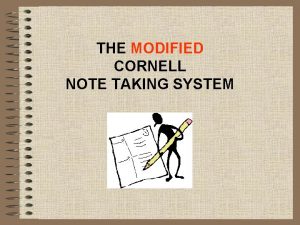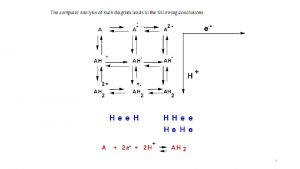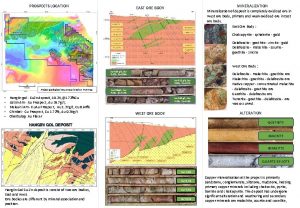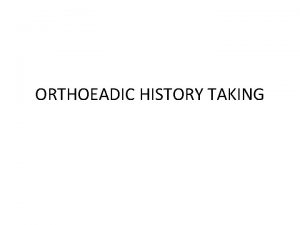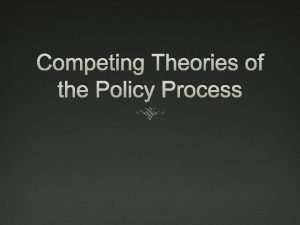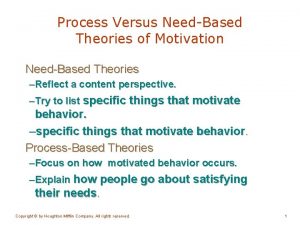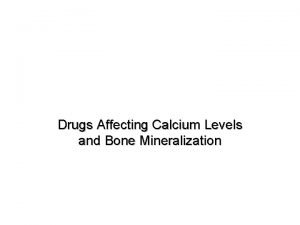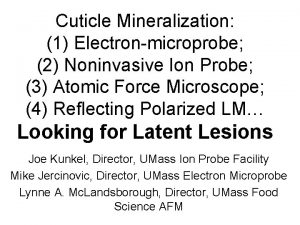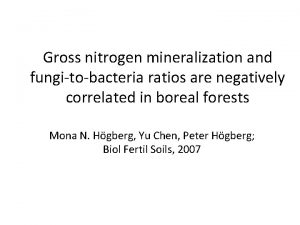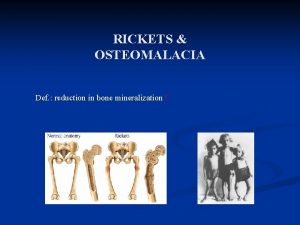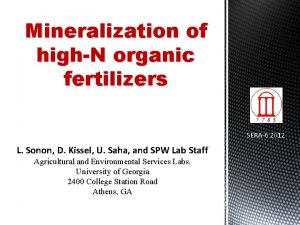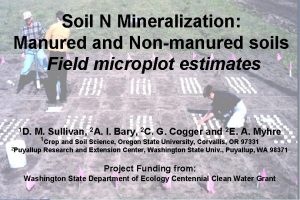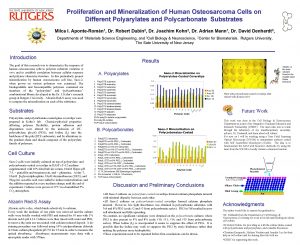Theories of Mineralization MINERALIZATION is a process taking


























- Slides: 26

Theories of Mineralization

�MINERALIZATION is a process taking place in all calcified structures in the body like the bone & enamel. � • Defined as the deposition of the mineral salts in and around the organic matrix to make it a calcified structure.

Mineralization �Mineralization takes place by the deposition of inorganic substance mainly calcium on the organic portion of a hard tissue Hard tissues Inorganic Organic Enamel 96% 4% Dentin 70% 30% Cementum 45% 55% Bone 67% 33%

Components playing role in mineralization �Cells: They produce the organic matrix of hard tissues �Bone –> Osteoblasts �Enamel –> Ameloblasts �Dentin –> Odontoblasts �Cementum –> Cementoblasts �They possess abundant Mitochondria, Rough endoplasmic reticulum & Golgi apparatus

�Organic matrix: It consists of type 1 collagen & other type of macromolecules (Proteoglycans, Glycoprotein & Phospholipids) �Organic component of enamel consists of enamel proteins �Minerals: They form the inorganic portion of hard tissues �It generally consists of calcium in the form of calcium hydroxy apatite crystals

MINERALIZATION IN 2 CIRCUMSTANCES �HOMOGENOUS MINERALIZATION �Local increase in concentration of mineral…. allowing formation of sufficient crystallites required for mineralization. �HETEROGENOUS MINERALIZATION �Presence of nucleating substance that can act as a template for crystal formation �Nucleating substance can initiate mineralization even in the absence of increase in ionic concentration

�THREE THEORIES � • Booster theory � • Seeding theory � • Matrix vesicle theory

BOOSTER THEORY � • Robinson’s ALKALINE PHOSPHATASE THEORY. � • 1923 � • Alk po 4 ase present in the organic matrix can hydrolyze organic phosphates such as pyrophosphates or glucose 1 -6 phosphate …. � • Release inorganic orthophosphate resulting in local increase in phosphate ion concentration.

� • Increase in local ion concentration has a boosting effect which would proportionately increase the proportion of phosphate ions to cause spontaneous precipitation. � • Phosphate ions combine with the calcium ions available in tissue fluid to form hydroxyapatite crystals. � • UNSTABLE AMORPHOUS CALCIUM PHOSPHATE IS CONVERTED TO CALCIUM HYDROXYAPATITE


� • THE BASIS OF ALKALINE PHOSPHATASE � • Calcifying cartilage contains more alkaline phosphatase than non calcifying cartilage. � • Slices of cartilage + incubated with calcium & organic phosphates= hydroxyapatite crystals were formed. � • Alk phosphatase is capable of splitting inorganic phosphates. Phosphates combine with calcium to produce apatite crystals

�Not widely accepted � • abnormal tissue (Rachitic bone- affected by richets) � • Alkaline phosphatase is observed in other tissues which do not calcify. � • Inhibitors of certain enzymes which do not inhibit alkaline phosphatase activity are found to be preventing mineralization. � • Studies have shown that presence of inorganoic phosphate and calcium is not sufficient to induce mineralization. This also requires action of some other enzymes. � • The organic phosphate presnt in tissue fluid of calcifying matrix is insufficient to produce sufficient inorganic phosphate ions to induce mineralization

The role of alkaline phosphatase in mineralization � • Group of enzymes that can cleave po 4 ions from organic phosphates at an alkaline p. H. � • Enzyme found in cell membrane of hard tissue forming cells and in organic matrix of calcifying tissue. � • May be involved in ion transport. � • Neumann ……. alkaline phosphatase may be playing an important role in mineralization by hydrolyzing pyrophosphate which is known as crystal poison which prevents mineralization therefore helping in crysral growth

Collagen seeding theory /nucleation theory /collagen template theory � • SPATIAL ARRANGEMENT. � • Can act as mould on template upon which crystals can be laid down. � • Nucleating substance can initiate mineralization even when the ionic concentration is less and also reduce energy required for mineralization.

� • Collagen =seed � • Amino acid present in collagen with charged side chains provide a specific spatial arrangement that can constitute a template matching hydroxyapatite. � • Calcium and phosphate ions present in the extracellular fluid binds to these sites to form hydroxyapatite crystals which further grow by addition of ions.

�Collagen was added to a solution containing calcium and phosphate, crystal formation was found even when the concentration of ions were lower than what is required for spontaneous mineralization……. . Seeding capacity of collagen

� • The gaps between collagen molecules are filled with proteoglycans which bind to calcium, � • Calcium is released by enzymatic degradation of proteoglycans. � • After the removal of proteoglycans phosphoproteins are attached to collagen which is broken down by alkaline phosphatase to give rise to phosphate ion. � • Ions combine to form apatite crystals in the gap zone of collagen

�Theory is unable to explain mineralization in all tissues. � • Enamel is highly mineralised but does not contain collgaen. � • Mineralization of cartilage begins in ground substance and not in association with collagen, .

�OTHER NUCLEATING MATERIALS � • Lipids �Phospholipids to amorphous calcium phosphate. �Phospholipids are also found in matrix vesicle � • Protein polysaccharides act as seed for mineralization. � • Proteoglycans and glycosaminoglycans have the capability of binding to calcium ions. � • protein polysaccharides regulate mineralization rather than initiation

Matrix Vesicle theory � • MEMBRANE BOUND VESICLES ISOLATED FROM AREAS OF CALCIFICATION. � • Structures bud off from synthetic cells and are released into organic matrix. � • Matrix vesicles induces precipitation � • Matrix vesicles have the capacity to initiate mineralization.

Two types � • Type i: round or ovoid …. . Containing lysosomes … � • Enzymes such as acid phosphatase and aryl phosphatase. � • Enzymes breakdown proteoglycans and glycosaminoglycans……. Which are inhibitors of mineralization

� • Type ii: matrix vesicles are irregular membrane bound structures having enzymes such as ATPase, alkaline phosphatase, pyrophosphatase, proteoglycans, metalloproteinases but relatively less acid phosphatase. � • Phospholipids …. great affiinity for calcium.

Role of matrix vesicle in mineralization � • Provides local environment for initial crystal formation. � • All the characteristics needed for induction of calcification. � • Freshly isolated vesicles contain relatively high calcium content bound to phospholipids which act as a nucleating site within the vesicle

� • Rich in alkaline phosphatase activity, the vesicles have the capacity to hydrolyze a variety of organic phosphate. substrates……. increases substantially the local availability of free phosphate ions to initiate apatite crystallization � • Removal of inhibitors of mineralization. � • ANNEXIN V…. . membrane associated protein mediating influx of calcium into matrix vesicles, enabling crystal growth.

� • Type ii and type x collagen. The first crystal formed is the matrix vesicle. � • The crystal growth continues in vesicle by further addition of ions which is followed by rupture of vesicle membrane. � • The crystals are released into the organic matrix…. . growing using ions in the tissue fluid and mineralization surrounding the matrix.

All three mechanisms(theories) involved in mineralisation � • Collagen acts as a seed and helps in intrafibrillar calcification. � • Similarly matrix vesicles help in extra fibrillar calcification. � • Alkaline phosphatase helps in providing more phosphate ions and also remove crystal poison.
 Robinsons alkaline phosphatase theory of mineralization
Robinsons alkaline phosphatase theory of mineralization Biochemical process
Biochemical process Note taking process
Note taking process 5 steps of focused note taking
5 steps of focused note taking Order taking process
Order taking process Focused note taking process
Focused note taking process Focused note taking process
Focused note taking process Matzas
Matzas What is social process theory
What is social process theory Social process theories criminology
Social process theories criminology Social process theories criminology
Social process theories criminology Social process theories
Social process theories Informed action
Informed action Perspective taking goals
Perspective taking goals Anna neary
Anna neary Difference between note making and note taking
Difference between note making and note taking Someone is taking someone for a walk cartoon meaning
Someone is taking someone for a walk cartoon meaning Pirates test taking strategy
Pirates test taking strategy Venipuncture and blood taking technique
Venipuncture and blood taking technique Modified cornell notes
Modified cornell notes The biggest risk is not taking any risk
The biggest risk is not taking any risk Tips for taking the act
Tips for taking the act Sample history
Sample history In a stressful situation feelings of pain are dulled by
In a stressful situation feelings of pain are dulled by Test taking anxiety symptoms
Test taking anxiety symptoms The call of elisha
The call of elisha Taking things without asking
Taking things without asking
